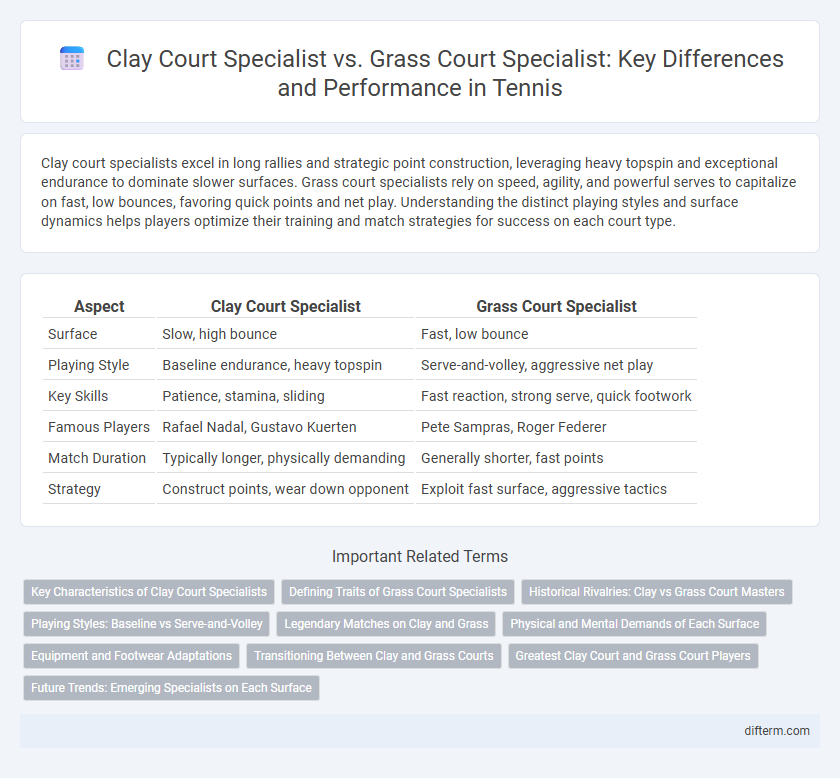Clay court specialists excel in long rallies and strategic point construction, leveraging heavy topspin and exceptional endurance to dominate slower surfaces. Grass court specialists rely on speed, agility, and powerful serves to capitalize on fast, low bounces, favoring quick points and net play. Understanding the distinct playing styles and surface dynamics helps players optimize their training and match strategies for success on each court type.
Table of Comparison
| Aspect | Clay Court Specialist | Grass Court Specialist |
|---|---|---|
| Surface | Slow, high bounce | Fast, low bounce |
| Playing Style | Baseline endurance, heavy topspin | Serve-and-volley, aggressive net play |
| Key Skills | Patience, stamina, sliding | Fast reaction, strong serve, quick footwork |
| Famous Players | Rafael Nadal, Gustavo Kuerten | Pete Sampras, Roger Federer |
| Match Duration | Typically longer, physically demanding | Generally shorter, fast points |
| Strategy | Construct points, wear down opponent | Exploit fast surface, aggressive tactics |
Key Characteristics of Clay Court Specialists
Clay court specialists excel in constructing points with heavy topspin, exceptional endurance, and strategic patience, enabling them to dominate long rallies. Their superior slide technique and strong baseline play allow them to effectively control the slower surface and exploit opponents' weaknesses. Mastery in movement and tactical shot selection distinguishes clay court experts from their grass court counterparts, who rely more on speed and serve-and-volley tactics.
Defining Traits of Grass Court Specialists
Grass court specialists exhibit exceptional serve-and-volley skills, leveraging the fast pace and low bounce of grass courts to dominate points quickly. Their agility and ability to execute precise, flat groundstrokes allow them to maintain control during rapid exchanges near the net. Consistent success on grass also demands strong mental focus and adaptability to variable surface conditions, which distinguish these players from clay court specialists.
Historical Rivalries: Clay vs Grass Court Masters
Rafael Nadal, renowned as the clay court specialist, has dominated the French Open with a record 14 titles, showcasing unparalleled expertise on clay surfaces. In contrast, Roger Federer, a grass court maestro, boasts eight Wimbledon championships, highlighting his mastery on the fast, low-bounce grass courts. Their historic rivalry epitomizes the tactical and stylistic contrasts between clay and grass court specialists, influencing tennis strategies and fan expectations across generations.
Playing Styles: Baseline vs Serve-and-Volley
Clay court specialists excel with heavy topspin and patient baseline rallies, exploiting the slow surface to wear down opponents through consistent groundstrokes and strategic point construction. Grass court specialists favor serve-and-volley tactics, leveraging the fast, low-bouncing surface to rush the net and shorten points with effective volleys and strong serves. Playing styles differ significantly as clay courts reward endurance and precision from the baseline, while grass courts prioritize quick reflexes, aggressive net play, and powerful serving.
Legendary Matches on Clay and Grass
Rafael Nadal's dominance on clay courts is epitomized by his numerous French Open victories, including the legendary 2008 final against Roger Federer, showcasing intense baseline rallies and unmatched endurance. Conversely, Roger Federer's mastery on grass is highlighted by his record eight Wimbledon titles, with the 2007 final against Nadal serving as a classic example of swift serves and elegant net play. These contrasting surfaces emphasize unique playing styles and have produced some of the most memorable epic matches in tennis history.
Physical and Mental Demands of Each Surface
Clay court specialists endure prolonged baseline rallies demanding exceptional endurance and strategic point construction, as the slower surface requires patient shot-making and resilience. Grass court specialists face faster gameplay with low, unpredictable ball bounces, relying on explosive agility, quick reflexes, and mental adaptability to capitalize on rapid point opportunities. Physical strain varies: clay courts demand sustained aerobic fitness, while grass courts emphasize anaerobic bursts and acute focus under pressure.
Equipment and Footwear Adaptations
Clay court specialists often prefer tennis shoes with a herringbone tread pattern designed to provide optimal grip and allow for sliding on loose clay surfaces, while their racquet strings may be tuned for more spin generation to exploit the slower court speed. In contrast, grass court specialists typically use shoes with nubbed or pimply soles for better traction on slippery grass and favor racquet string tensions that enhance control and reduce ball skidding on the fast, low-bounce grass courts. Equipment adaptations are essential for maximizing performance, with clay-court gear emphasizing durability and slide control, whereas grass-court setups prioritize stability and precise shot execution.
Transitioning Between Clay and Grass Courts
Transitioning between clay and grass courts challenges players due to contrasting surface speeds and ball bounces, demanding adaptations in footwork and stroke technique. Clay court specialists excel in long rallies and sliding movements, while grass court specialists thrive on fast, low bounces and aggressive serve-and-volley tactics. Mastering this transition involves adjusting timing, movement patterns, and shot selection to maintain performance across both surfaces.
Greatest Clay Court and Grass Court Players
Rafael Nadal stands as the greatest clay court specialist, securing a record 14 French Open titles and dominating the surface with unparalleled topspin and endurance. On grass courts, Roger Federer excels with eight Wimbledon championships, showcasing elegant footwork and precise serve-and-volley techniques. Their contrasting mastery on clay and grass highlights the distinct skills required to conquer the sport's premier tournaments on different surfaces.
Future Trends: Emerging Specialists on Each Surface
Future trends in tennis highlight rising clay court specialists mastering heavy topspin and endurance for slow rallies, while grass court specialists emphasize swift footwork and aggressive serve-and-volley tactics. Emerging talents equipped with advanced analytics and tailored training are refining techniques specific to each surface's unique bounce and speed characteristics. The integration of sport science innovations is accelerating the development of players who can dominate rapidly evolving playing conditions on both clay and grass courts.
Clay court specialist vs grass court specialist Infographic

 difterm.com
difterm.com